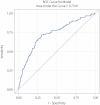Utility of using electrocardiogram measures of heart rate variability as a measure of cardiovascular autonomic neuropathy in type 1 diabetes patients
- PMID: 34309223
- PMCID: PMC8756321
- DOI: 10.1111/jdi.13635
Utility of using electrocardiogram measures of heart rate variability as a measure of cardiovascular autonomic neuropathy in type 1 diabetes patients
Abstract
Aims/introduction: Cardiovascular autonomic neuropathy (CAN) is a predictor of cardiovascular disease and mortality. Cardiovascular reflex tests (CARTs) are the gold standard for the diagnosis of CAN, but might not be feasible in large research cohorts or in clinical care. We investigated whether measures of heart rate variability obtained from standard electrocardiogram (ECG) recordings provide a reliable measure of CAN.
Materials and methods: Standardized CARTs (R-R response to paced breathing, Valsalva, postural changes) and digitized 12-lead resting ECGs were obtained concomitantly in Diabetes Control and Complications Trial/Epidemiology of Diabetes Interventions and Complications participants (n = 311). Standard deviation of normally conducted R-R intervals (SDNN) and the root mean square of successive differences between normal-to-normal R-R intervals (rMSSD) were measured from ECG. Sensitivity, specificity, probability of correct classification and Kappa statistics evaluated the agreement between ECG-derived CAN and CARTs-defined CAN.
Results: Participants with CARTs-defined CAN had significantly lower SDNN and rMSSD compared with those without CAN (P < 0.001). The optimal cut-off points of ECG-derived CAN were <17.13 and <24.94 ms for SDNN and rMSSD, respectively. SDNN plays a dominant role in defining CAN, with an area under the curve of 0.73, indicating fair test performance. The Kappa statistic for SDNN was 0.41 (95% confidence interval 0.30-0.51) for the optimal cut-off point, showing fair agreement with CARTs-defined CAN. Combining SDNN and rMSSD optimal cut-off points does not provide additional predictive power for CAN.
Conclusions: These analyses are the first to show the agreement between indices of heart rate variability derived from ECGs and the gold standard CARTs, thus supporting potential use as a measure of CAN in clinical research and clinical care.
Keywords: Cardiovascular autonomic neuropathy; Cardiovascular reflex tests; Heart rate variability.
© 2021 The Authors. Journal of Diabetes Investigation published by Asian Association for the Study of Diabetes (AASD) and John Wiley & Sons Australia, Ltd.
Conflict of interest statement
BHB, GL and JML report receiving grants from National Institute of Diabetes, Digestive and Kidney Diseases, during the conduct of the study. RPB, JYB, IB, NHW and EZS declare no conflict of interest.
Figures


References
-
- Pop‐Busui R, Low PA, Waberski BH, et al. Effects of prior intensive insulin therapy on cardiac autonomic nervous system function in type 1 diabetes mellitus: the Diabetes Control and Complications Trial/Epidemiology of Diabetes Interventions and Complications study (DCCT/EDIC). Circulation 2009; 119: 2886–2893. - PMC - PubMed
-
- Pop‐Busui R, Cleary PA, Braffett BH, et al. Association between cardiovascular autonomic neuropathy and left ventricular dysfunction: DCCT/EDIC study (Diabetes Control and Complications Trial/Epidemiology of Diabetes Interventions and Complications). J Am Coll Cardiol 2013; 61: 447–454. - PMC - PubMed
Publication types
MeSH terms
Grants and funding
LinkOut - more resources
Full Text Sources
Medical

